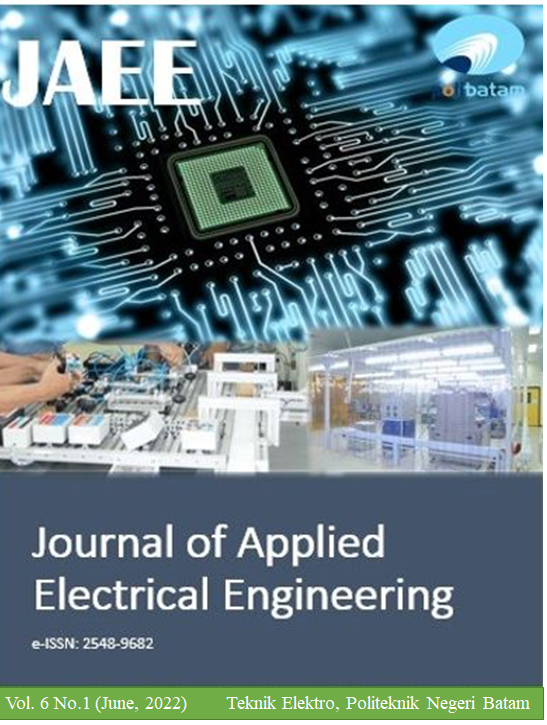Analisis Daya Piezoelektrik Pada Alat Pencegahan Penyebaran Coronavirus Terintegrasi IoT
DOI:
https://doi.org/10.30871/jaee.v6i1.4051Keywords:
Indonesia, Coronavirus, Harvesting Energy, IoT, PiezoelektrikAbstract
The innovation of the health protocol system for the prevention of the corona virus with an energy source of piezoelectric as independent electricity, namely the use of the concept of energy harvesting, converts the vibration or pressure generated by the footrests into electrical energy. The prototype system uses a piezoelectric ladder to generate power and a charging module to recharge from the battery. The power required is 60 watts. The charging aims to activate the entire system, namely by washing hands and sensors detecting masks and measuring body temperature which are all carried out in parallel. The camera sensor is able to distinguish the use of masks, so that your photos will be accurate and consistent. The Raspberry Pi controller communicates with the website server, which in turn controls various aspects of the system. The results of the process will be integrated with IoT and stored in a database, and the results will be displayed on a website as a monitoring process. If the system determines that the required health protocols are complete, the door will open automatically. The camera sensor accuracy is averaged out to be 98.5% accurate. In testing the whole system with around 40 kg of mass, which results in an average output voltage of 3.18 V and a current of 1.38 A and a foot step 3.517, 50 kg, the output voltage was 3.88 V, Current was 2.08 A and a step of 2,298 feet and 60 kg, resulting in an average voltage of 5.28 V, a current of 3.42 A and an average pedestrian frequency of 1.494.
Downloads
References
Muhyiddin, "Covid-19, New Normal dan Perencanaan Pembangunan di Indonesia," The Indonesian Journal of Development Planning, vol. IV, no. No 2, Jun. 2020.
Y. Sudiyani and S. Aiman, Perkembangan Bioetanol G2: Teknologi dan Perspektif, 1st ed., vol. 1. Jakarta: LIPI Press, 2019.
N. Sezer and M. Koç, "A Comprehensive Review on The State-of-The-Art of Piezoelectric Energy Harvesting," Nano Energy, vol. 80, p. 105567, Feb. 2021, doi: 10.1016/J.NANOEN.2020.105567.
A. Aabid et al., "A systematic review of piezoelectric materials and energy harvesters for industrial applications," Sensors, vol. 21, no. 12, Jun. 2021, doi: 10.3390/s21124145.
P. Dhingra, S. S. Meher, J. Biswas, A. Prasad, M. I. T. Manipal, and S. S. Meher, "Energy Harvesting using Piezoelectric Materials," 2013. [Online]. Available: https://www.researchgate.net/publication/267568019
A. Hendriawan and D. Cahya Happyanto, "Piezoelectric Sebagai Alternatif Catu Daya Tambahan pada Mobil Listrik," Inovtek, vol. 4, no. 1, pp. 26"“33, Apr. 2014.
M. I. Mowaviq, A. Junaidi, D. S. Purwanto, and S. Tinggi Teknik -Pln, "Lantai Permanen Energi Listrik Menggunakan Piezoelektrik," Energi & Kelistrikan, vol. 10, no. 2, pp. 112"“118, Jan. 2018, doi: 10.33322/ENERGI.V10I2.219.
M. Safaei, H. A. Sodano, and S. R. Anton, "A review of Energy Harvesting using Piezoelectric Materials: State-of-the-art a decade later (2008-2018)," Smart Materials and Structures, vol. 28, no. 11, Oct. 2019, doi: 10.1088/1361-665X/ab36e4.
W. Hidayatullah and M. Syukri, "Perancangan Prototype Penghasil Energi Listrik Berbahan Dasar Piezoelektrik," KITEKTRO: Jurnal Online Teknik Elektro, vol. 1, no. 3, pp. 63"“67, 2016.
D. Prihatmoko, "Pemanfaatan Raspberry Pi Sebagai Server Web untuk Penjadwalan Kontrol Lampu Jarak Jauh," Jurnal INFOTEL, vol. 9, no. 1, p. 84, Feb. 2017, doi: 10.20895/infotel.v9i1.159.
M. Chavan, S. Chauhan, M. Singh, and A. Tripathi, "Footstep Power Generation using Piezoelectric Sensor and Distribution using RFID," International Research Journal of Engineering and Technology, vol. 07, no. 09, pp. 1416"“1420, Sep. 2020, [Online]. Available: www.irjet.net
Downloads
Published
How to Cite
Issue
Section
License
Authors who publish with this journal agree to the following terms:
- Authors retain copyright and grant the journal right of first publication with the work simultaneously licensed under a Creative Commons Attribution License (Attribution-ShareAlike 4.0 International (CC BY-SA 4.0) ) that allows others to share the work with an acknowledgment of the work's authorship and initial publication in this journal.
- Authors are able to enter into separate, additional contractual arrangements for the non-exclusive distribution of the journal's published version of the work (e.g., post it to an institutional repository or publish it in a book), with an acknowledgment of its initial publication in this journal.
- Authors are permitted and encouraged to post their work online (e.g., in institutional repositories or on their website) prior to and during the submission process, as it can lead to productive exchanges, as well as earlier and greater citation of published work (See The Effect of Open Access).
Open Access Policy
This journal provides immediate open access to its content on the principle that making research freely available to the public supports a greater global exchange of knowledge. Its free availability on the public internet, permitting any users to read, download, copy, distribute, print, search, or link to the full texts of these articles, crawl them for indexing, pass them as data to software, or use them for any other lawful purpose, without financial, legal, or technical barriers other than those inseparable from gaining access to the internet itself.















